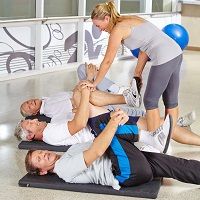Studies: Exercise and Sleep Are Key in Ankylosing Spondylitis
A recent study suggests that patients with ankylosing spondylitis (AS) have a higher incidence of obstructive sleep apnea syndrome that increases with the severity of cervical vertebral involvement. A separate study published on the same day suggests that specific exercise regimens may be beneficial for patients with AS.

A recent study suggests that patients with ankylosing spondylitis (AS) have a higher incidence of obstructive sleep apnea syndrome (OSAS) that increases with the severity of cervical vertebral involvement. A separate study published on the same day suggests that specific exercise regimens may be beneficial for patients with AS.
The first study, published in Archives of Rheumatology, is among the first to look to try to quantify the prevalence of OSAS in patients with AS. Difficulty sleeping has a cyclical effect on many conditions, and also contributes to lower quality of life, stress, and learning difficulties, among others. OSAS is a formidable condition in its own right, as it is associated with increased mortality and morbidity, hypertension, cardiovascular disease, and fatigue.
The study tested 42 patients (36 males, six females; mean age 39.4±9.1 years; range 23 to 63 years) with AS with an overnight polysomnography test and found that 13 patients (30.9%) had OSAS. In addition, there was a positive correlation between apnea hypopnea index and occiput- to-wall distance and neck circumference (r=0.355, p=0.021; r=0.413, p=0.007, respectively) whereas apnea hypopnea index and body mass index did not significantly correlate.
There was no statistically significant difference between the groups regarding mean BMI, disease duration, or duration of the morning stiffness. However, occiput-to-wall distance and neck circumference were significantly greater in patients with OSAS (p=0.025, p=0.004, respectively).
“Our results suggest that increased number of awakenings and reduced sleep efficiency were not correlated to disease duration, but rather severity,” the study authors noted. “This may be due to increased pain sensation in these patients. Increased disease severity and worsened dysfunction lead to increased pain sensation, resulting in frequent awakenings and reduced sleep efficiency.”
One limitation of the study is that it enrolled patients who agreed to spend a night in a sleep center for the sleep measurement; these are likely to be patients with more severe sleep-related symptoms and this could lead to selection bias. Also, the study sample was limited in size due to the nature of the overnight sleep measurement.
“To our knowledge, our study is the first demonstrating the relationship between OSAS and spinal changes in patients with AS,” the study authors concluded.
The second study, published in Seminars in Arthritis & Rheumatism, pointed out that, “Despite Level 1b evidence and international consensus that exercise is beneficial in AS, there is a paucity of detailed information to guide exercise prescription, including the type and dosage of exercise required for the most benefit.”
During a two-day meeting, rheumatologists reviewed the literature and obtained feedback from patient and health professional groups, then developed draft exercise recommendations for patients with AS.
“The recommendations provide an up-to-date, evidence-based approach to the full range of issues related to the use of exercise in AS, as well as identifying evidence gaps for further research,” the study authors noted, “[including] … the specific exercise requirements of sub-groups of people with AS. Widespread dissemination and implementation of the guidelines will be required to optimise exercise outcomes.”